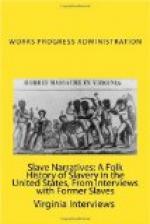“When the Civil War came on there was great excitement among we slaves. We were watched sharply, especially soldier timber for either army. My husband ran away early and helped Grant to take Fort Donaldson. He said he would free himself, which he did; but when we were finally set free all our family prepared to leave. The Master begged us to stay and offered us five pounds of meal and two pounds of pork jowl each week if we would stay and work. We all went to Burgard, Kentucky, to live. At that time I was about 34 years old. My husband has been dead a long time and I live with my children. If the “Good Lord” spares me until next March the 25th, I will be 106 years old. I walk all about lively without crutches and eye-glasses and I have never been sick until this year when a tooth gave me trouble; but I had it pulled.”
Archie Koritz, Field Worker
Federal Writers’ Project
Porter County—District #1
Valparaiso, Indiana
Ex-slaves
Mrs. Hockaday
2581 Madison Street
Gary, Indiana
Mrs. Hockaday is the daughter of an ex-slave and like so many others does not care to discuss the dark side of slavery and the cruel treatment that some of them received.
After the Civil War the slaves who for the most part were unskilled and ignorant, found it very difficult to adjust themselves to their new life as free persons. Formerly, they lived on the land of their masters and although compelled to work long hours, their food and lodging were provided for them. After their emancipation, this life was changed. They were free and had to think for themselves and make a living. Times for the negro then was much the same as during the depression. Several of the slaves started out to secure jobs, but all found it difficult to adjust themselves to the new life and difficult to secure employment. Many came back to their old owners and many were afraid to leave and continued on much as before.
The north set up stores or relief stations where the negro who was unable to secure employment could obtain food and shelter. Mrs. Hockaday says it was the same as conditions have been the last few years.
About all the negro was skilled at was servant work and when they came north, they encountered the same difficulties as several of the colored folks who, driven by the terrible living conditions in the south four years ago, came to Gary. Arriving here they believed they were capable of servant work. However they were not accustomed to modern appliances and found it very difficult to adjust themselves. It was the same after the Emancipation.
Many owners were kind and religious and had schools for their slaves, where they could learn to read and write. These slaves were more successful in securing employment.
Although the negro loved the Bible most of all books, and were mostly Methodists and Baptists, their different religious beliefs is caused by the slave owners having churches for the slaves. Whatever church the master belonged to, the slaves belonged to, and continued in the same church after the war.




